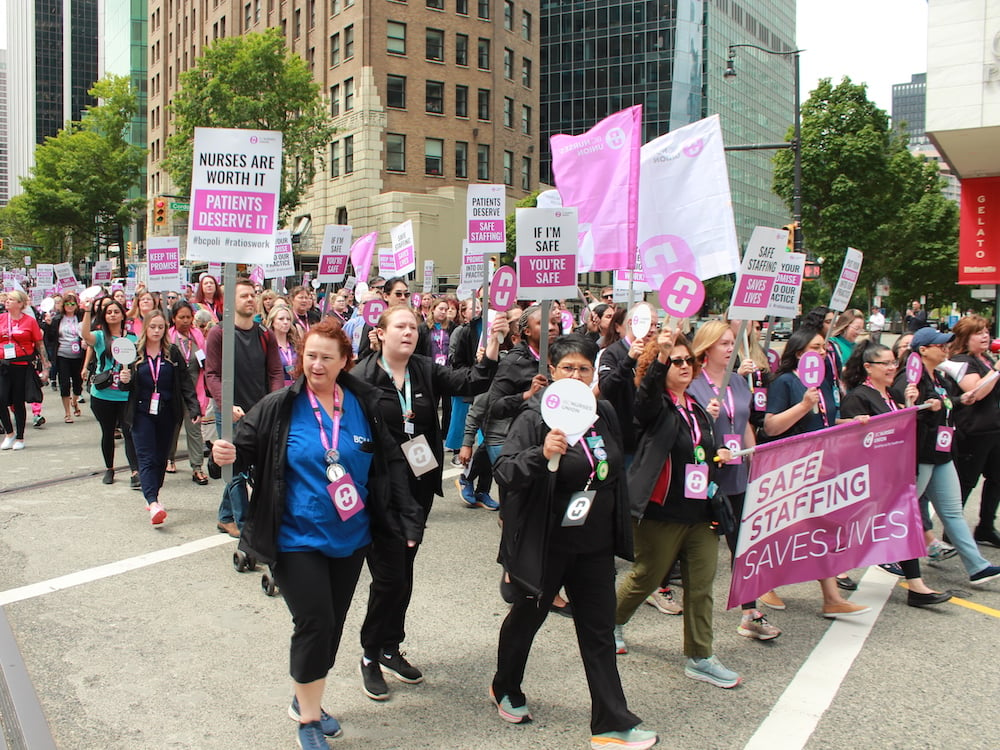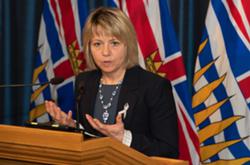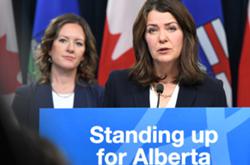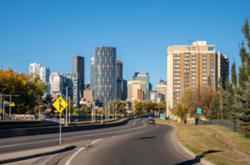The BC NDP’s 2024 budget focused on building out the province’s health-care system to meet the demands of a growing and aging population.
Health experts told The Tyee these investments make sense — but they also said the government could have gone a lot further to address root issues facing public health.
The budget did not include, for example, new spending for drug treatment or harm reduction services, despite unregulated drugs being the leading cause of death in the province for people aged 10 to 59.
Nicole Luongo, systems change co-ordinator with the Canadian Drug Policy Coalition, said she’s disappointed but not surprised the BC NDP didn’t commit to bold reforms to tackle the ongoing crisis, which killed 2,511 British Columbians last year.
“Drug policy has become so polarized,” she said. “They seem quite content to maintain the status quo, even though clearly the status quo is not working.”
Hospital Employees’ Union secretary-business manager Meena Brisard said she’s “pleased with the budget” because it doesn’t look like there’s going to be wage cuts or layoffs for health-care workers.
Some of the $6 billion earmarked to be spent on health over the next three years will be spent on wage adjustments thanks to the union’s latest round of collective bargaining, but overall these are “record investments into public health care,” Brisard said.
According to budget documents, around half the money will go towards improving emergency care in rural and Indigenous communities by bolstering staffing capacity, adding virtual services and funding ground and air ambulance, and preparing for future pandemics by investing in vaccines and personal protective equipment.
Around $2 billion over three years will go towards building out the health-care system and filling staffing vacancies as much of the aging workforce retires. The budget document says the province “needs newcomers” to meet its labour needs, suggesting the government plans to recruit skilled immigrants.
BC Nurses’ Union president Adriane Gear told The Tyee she was surprised the budget was missing targeted investments to hire and retain nurses. In B.C. there are 5,465 nursing positions sitting vacant, which is a symptom of the global nursing shortage, she said. Nurses leave the profession when they are given more patients than they can care for, experience high rates of workplace violence or struggle with affordability challenges, she said.
Last spring B.C. said it would adopt minimum nurse-to-patient ratios, which should help reduce workplace stress but will increase the number of staffing vacancies, Gear said. These ratios have not yet been implemented.
The budget also includes $13 billion over the next three years in capital investments to keep building and upgrading hospitals across the province.
The most expensive projects will be the new Surrey hospital and BC Cancer Centre, ringing in at $2.9 billion, followed by the new St. Paul’s Hospital at $2.2 billion and the Burnaby Hospital redevelopment Phase 2 and 3 for an anticipated total of $1.7 billion.
“Nice new buildings and additional beds are important, but without staff it’s just a nice new building,” Gear said, drilling home the importance of programs that help recruit and retain health-care workers.
Money will also go towards building or upgrading seniors’ care homes in Abbotsford, Cranbrook, Nanaimo and Prince George. Brisard said she is “very excited” the homes will be either publicly operated or not-for-profit because “every dollar invested in seniors should go directly into patient care, not profits.”
B.C. Seniors Advocate Isobel Mackenzie said she was hoping to see funds for the Shelter Aid for Elderly Renters program but was disappointed.
“Seniors who are renting are in desperate need of more rent relief,” she said. “The [program’s] rent ceilings and income caps are far too low and need to be raised to reflect the rental market.”
The budget sets aside $354 million over three years to help seniors live at home longer, including $227 million for home health-care services provided by regulated professionals like physiotherapists and occupational therapists, and $127 million for community-based services to help with chores like grocery shopping and snow shovelling.
Mackenzie said supporting home health care is positive but represents only a small piece of the care seniors need. Other provinces publicly fund home support workers to help seniors with daily care, like staying on top of medications, she said, and she’d like to see B.C. introduce a similar program.
Brisard said that while she agreed with Mackenzie’s critiques, the new services would nonetheless alleviate some pressure from the health-care system. When services help seniors to have food in their cupboards and let them call a taxi instead of an ambulance to get themselves to a doctor’s appointment, it’s a good thing, she said.
To tackle the ongoing toxic drug overdose crisis, the budget allocates $117 million over the next three years to “continue funding” 2,200 treatment beds that can help patients struggling with substance use or mental health issues that would otherwise be defunded because of expiring contracts or needing more money to cover inflation-related costs.
B.C. currently has more than 20,000 treatment beds for mental health and substance use and 3,596 beds specifically for substance use. A Ministry of Mental Health and Addictions spokesperson said that thanks to funding allocated in previous budgets, more substance use treatment beds will be opening in the coming years, despite no funding going towards new beds in this budget.
The BC NDP likely sees drug policy as “too much of a political risk” to invest in during an election year, even though “what they’ve built is wildly inadequate,” Luongo said.
In B.C. addiction treatment isn’t regulated or required to be evidence-based, Luongo said. But tackling the issue opens a can of worms because it would require the governing party and opposition to admit they’ve been advocating for and funding services that “cause harms and lead to increased rates of fatal overdose,” she said.
The budget also allocates $49 million over three years to support existing harm reduction initiatives such as overdose prevention sites, drug-checking services and naloxone kit distribution programs.
B.C. has had a ministerial order in place since 2016 requiring overdose prevention sites to be opened “in any place there is a need for these services as determined by the level of overdose related morbidity and mortality.”
Since 2016 unregulated drugs have been growing exponentially more potent and have more addictive and dangerous substances, such as benzodiazepines, added to them. Even though some programs, such as the province’s 49 overdose prevention sites, have worked to reduce overdose deaths, the number of annual fatalities is now more than 2.5 times higher today than it was in 2016.
Luongo said the $49 million is important but ultimately a stopgap measure. To end the overdose crisis, B.C. needs to regulate all drugs so people can know the type and potency of substance they are using, she said.
B.C.’s provincial health officer and chief coroner have both supported a regulated drug supply, and have both suggested these substances could be distributed through non-medical models such as compassion clubs.
Health-focused budget spending also allocated $270 million over three years to keep building out the province’s 10-year cancer action plan.
The province has also allocated $68 million over two years for in vitro fertilization treatment, which is offered by many other provinces and territories.
Hopeful parents will get one round of medication and treatment covered “regardless of their relationship status, who they love and how much money they make” starting April 2025, according to budget documents. At $15,000 to $20,000 per treatment, this money will likely be able to help between 3,400 to 4,533 hopeful parents. ![]()
Read more: Health, BC Politics

















Tyee Commenting Guidelines
Comments that violate guidelines risk being deleted, and violations may result in a temporary or permanent user ban. Maintain the spirit of good conversation to stay in the discussion and be patient with moderators. Comments are reviewed regularly but not in real time.
Do:
Do not: